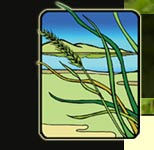FAQs on Mycorrhizal Fungi:
What are mycorrhizae?
Mycorrhizae are mutualistic relationships between soil fungus and plant roots. Scientist tell us that the relationship has been around for 400 million years although discovered in 1845 by a scientist in Germany.
Where can the introduction of mycorrhizal fungi with roots have the greatest effect?
In disturbed soils, the kinds found in landscape projects, restoration, new grove/orchards, and mine reclamation sites.
Is there mycorrhizae in the plants that I buy at the nursery?
Probably not. Even if there was a mycorrhizal fungi present in nursery stock the species that would thrive in a nursery setting would probably offer little benefit in a real world landscape, restoration, or forestry planting.
What about field grown plant materials — would they have beneficial mycorrhizal fungi associated with the roots?
Again, practices generally are geared to high production to turn inventories. Under highly managed operations any mycorrhizal fungi present would be poorly adapted to “real world” conditions found at out planting sites.
Are multi-species mycorrhizal inoculants really necessary?
Multiple species are very important because they increase the odds significantly that one of the selected species will prosper with the roots and multiply quickly.
Since mycorrhizal fungi may be present in the soil anyway why should I inoculate my transplants?
Although mycorrhizal fungi may be present the types (species) may not be the most effective for the plant species that is being planted. The introduction of diverse species at the time of planting greatly enhances the probability of successful colonization of the roots to take advantage of all of the benefits of mycorrhizal roots.
When buying an inoculant for mycorrhiza is the number of spores important?
Yes, the number of spores can be important, but more important is the degree of infectivity present in an inoculant. How effective an inoculant is depends on how rapid it can cause colonization of the root system. Spores tend to be the least infective of fungal parts in the genus Glomus (which comprise the majority of commercially available inoculants). Hyphal fragments are most infective, followed by mycorrhizal root fragments. All three infective components are referred to as propagules by INVAM. Make sure that the species used in the inoculant are diverse and have been proven to be effective over wide ranges of plant species, pH, and soil types. (DIEHARD™ species are proven — see a 40+ page reference list.) Consumers can be fooled by companies that claim high spore count but use weak, or ineffective spores, in the count that are easy to reproduce to achieve spore count specifications. Some spores too offer little potential for good colonization but the propagules of these species are the real potential partner to begin the colonization process. So, unfortunately, the answer to the question is both yes and no. The key here is to work with a company that has established itself in the market from top to bottom with high standards of products, customer service, and an honest effort to be a legitimate business partner with your company. Too often you can get sucked in with four-color advertising and fancy literature, but beyond the window dressing is a company out to take your money and give you junk — packaged in a pretty box!! It’s a fact that one company claims it product consists only of spores and that makes it the best product on the market, when in fact the company’s products are weak at best and when compared to other products are not superior and usually inferior. Know whom you're dealing with. Ask for references.
Lastly, some strains such as Glomus deserticola, Glomus microaggregatum, Glomus mosseae, and sometime Glomus intraradices produce clusters of spores very (like a popcorn ball”. Most of time, Glomus deserticola and Glomus microaggregatum produce clusters with as many as 500 spores minimum stuck together. Glomus mosseae produce external sporocarps (5-10 spores inside) or external clusters of "young spores" and Glomus dussii produce external sporocarps (containing hundred of very small spores) and also external spores entrapped within the external mycelium. Glomus intraradices produce large quantity of INTERNAL spores inside the root (hundred spores /cm of root can be counted sometime). All these "natural occurring” sporulation configurations are considered for the counting spores.
Endomycorrhizaes are not Ecto and this difference must be considered.
The most important aspect is the standardization of the product and the efficiency and quality.
If I am planting like type plants in an established setting is the use of a mycorrhizae inoculant still necessary?
Use of an inoculant here is probably not necessary although research shows that the species of mycorrhizal fungi most effective with young plants may be different than the species most effective with mature plants of the same plant species.
What differences are there between commercial suppliers available?
There are presently a dozen, or more, suppliers of mycorrhizal products. The differences are typical of what one would expect. There are two or three with good products, four or five with "so-so" products and three or four with real "dogs". Our advise to you is to ASK THE SUPPLIER FOR REFERENCES. If they can't give you references that you can RELATE to, or that you've at least heard of, then that speaks volumes about the company. If they give you some homeowner in Portland, OR that used the product with tomatoes and got really good results - who really cares if you're and arborist in New York! Hey come on, you're in business. Ask questions and decide on your own. . .



